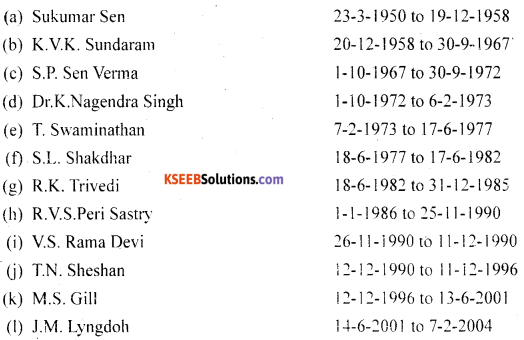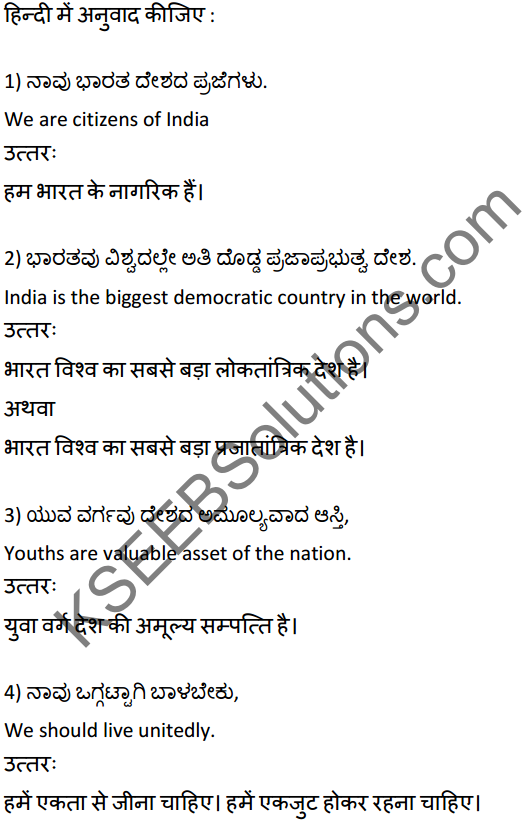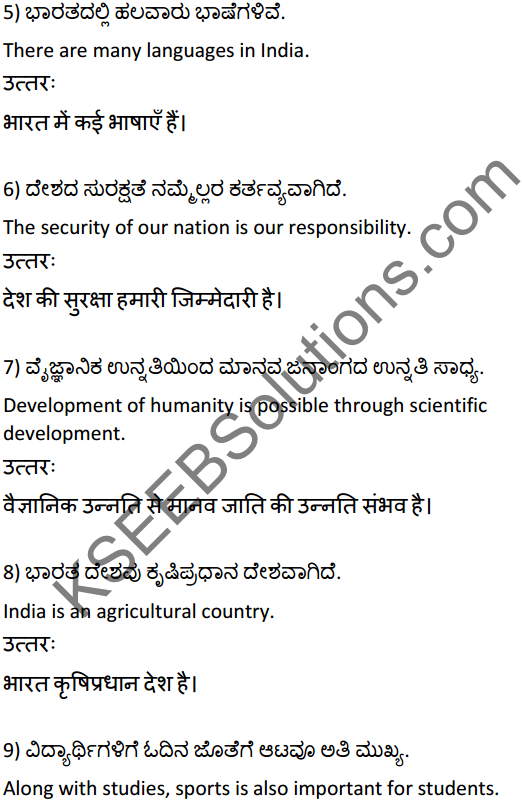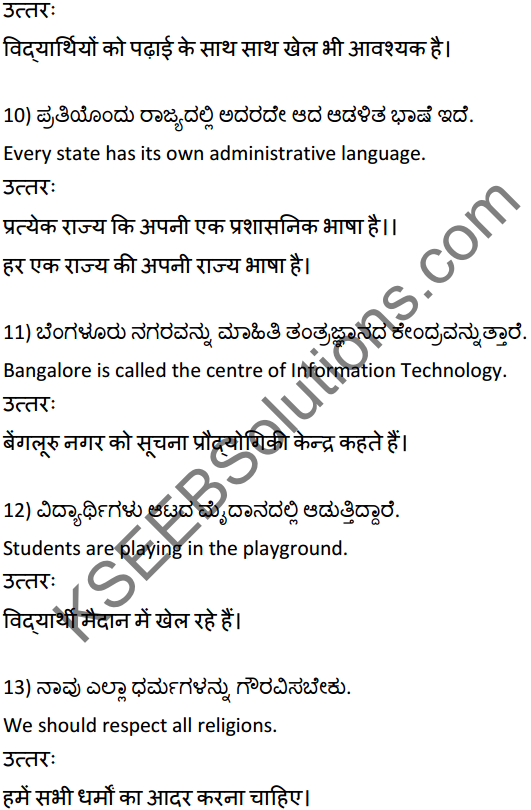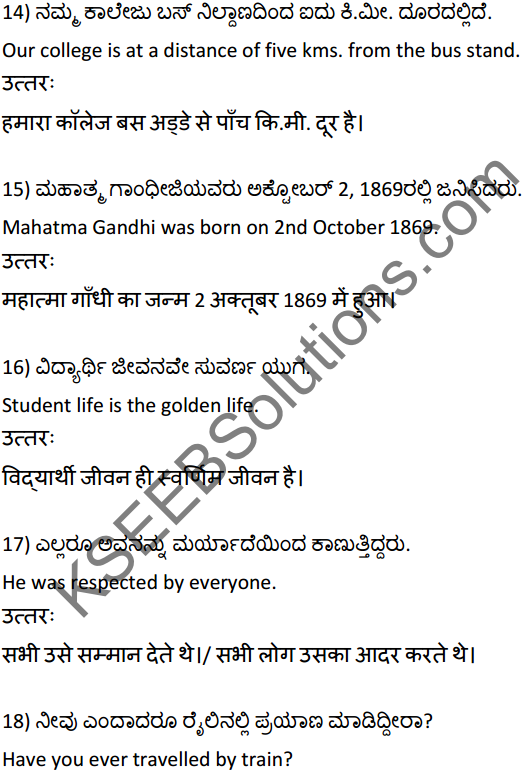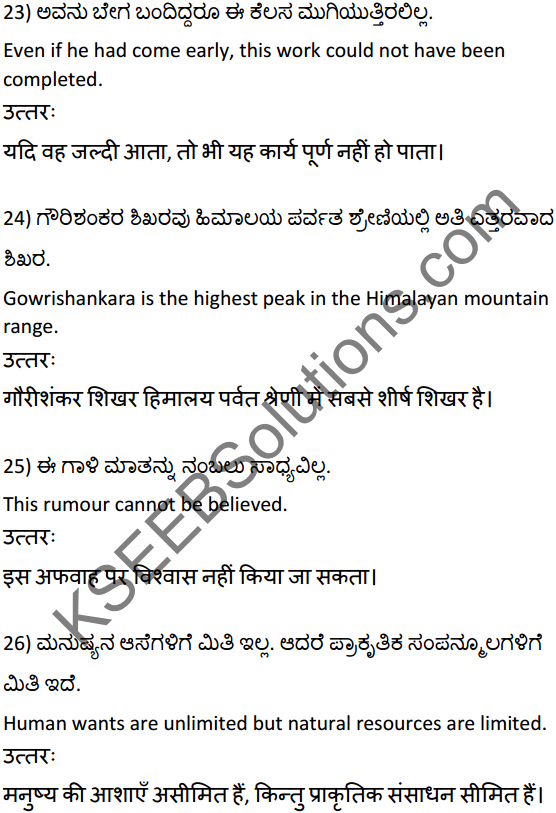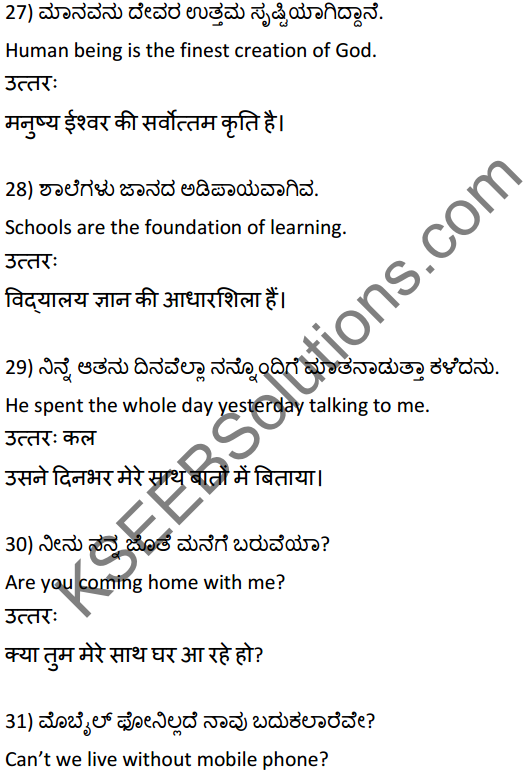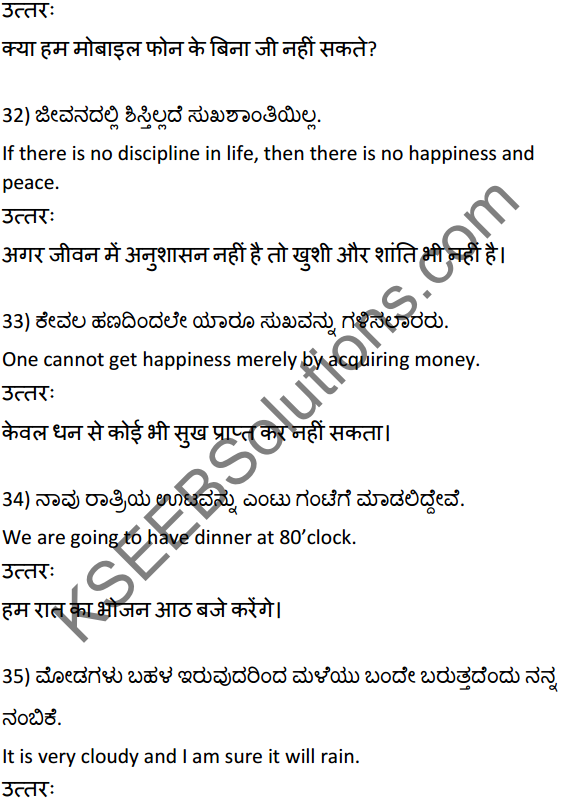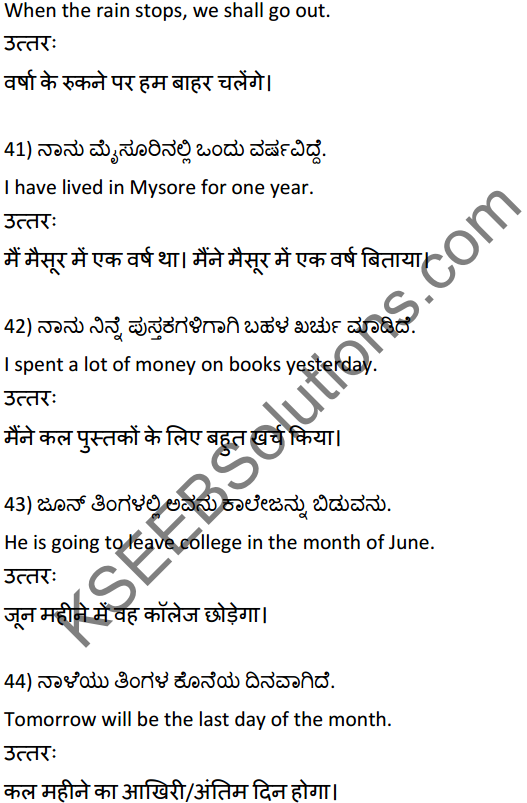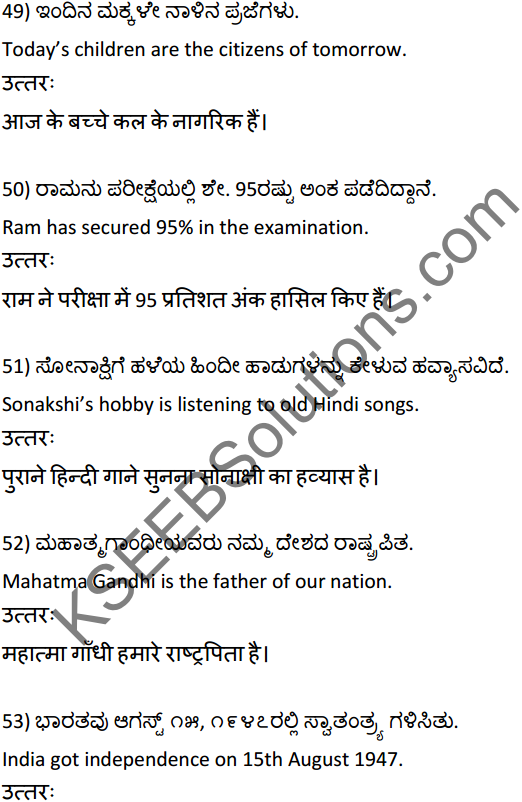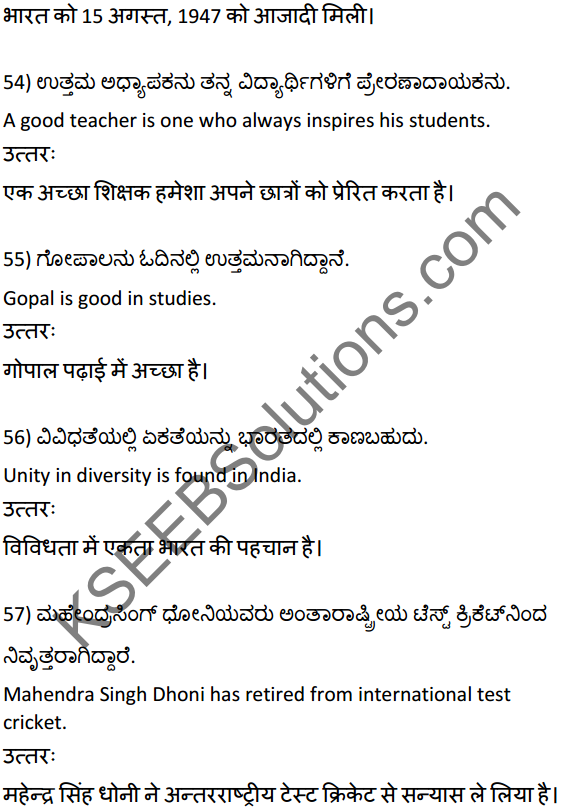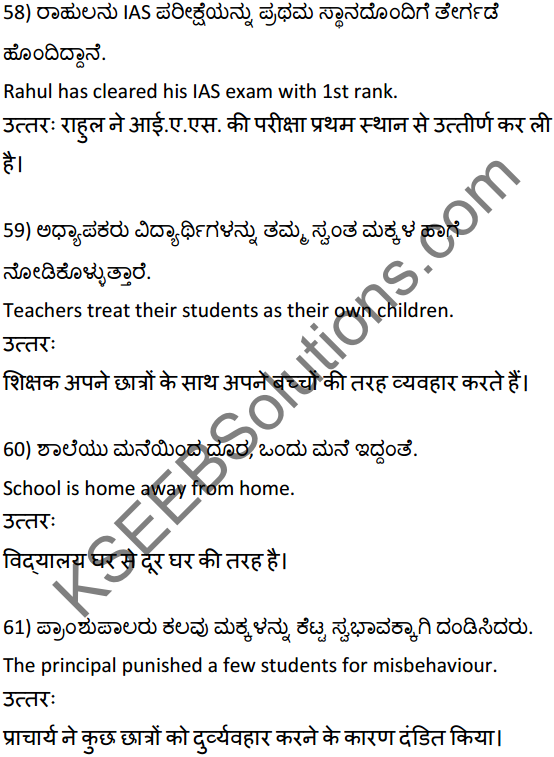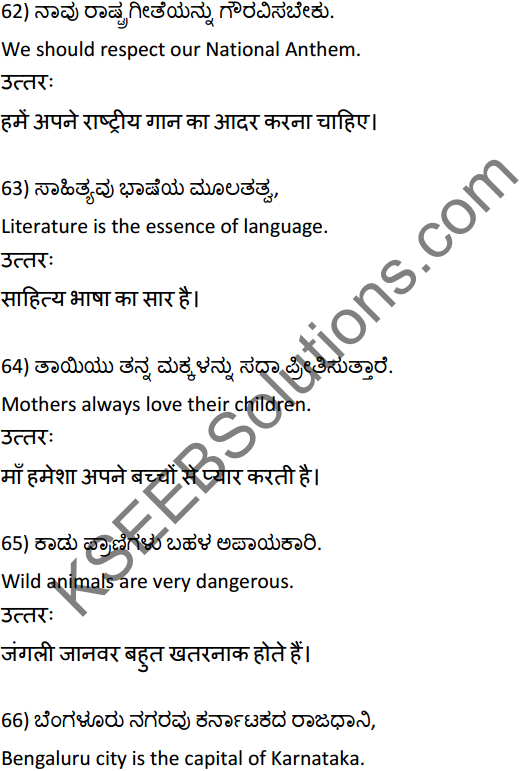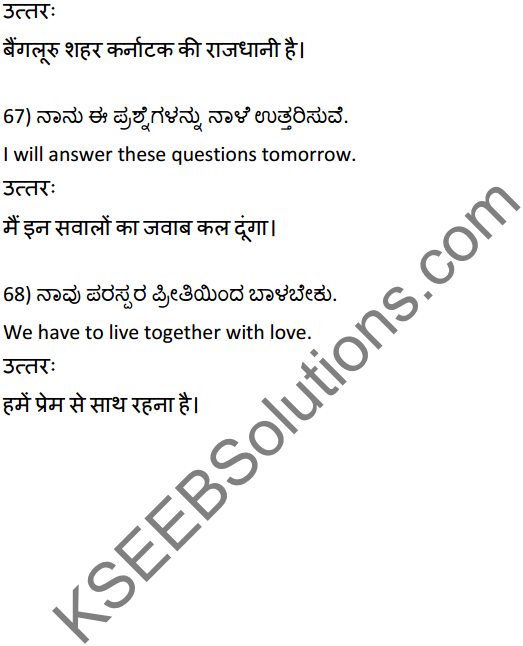You can Download Chapter 6 Socio-Religious Reform Movement In Medieval India Questions and Answers, Notes, 2nd PUC History Question Bank with Answers Karnataka State Board Solutions help you to revise complete Syllabus and score more marks in your examinations.
Karnataka 2nd PUC History Question Bank Chapter 6 Socio-Religious Reform Movement In Medieval India
2nd PUC History Socio-Religious Reform Movement In Medieval India One Mark Questions and Answers
I. Answer the following questions in one word or a sentences each.
Question 1.
Which was the birth place of Shankaracharya? (or) Where was Shankara born?
Answer:
Shankaracharya was bom at Kaladi in Kerala.
Question 2.
Name the Philosophy of Shankaracharya.
Answer:
Advaitha.
Question 3.
Name the Philosophy of Ramanujacharya, (or) What is the name of the Philosophy expounded by Ramanujacharya?
Answer:
Sri Vaishnava or Vishistadvaitha Philosophy was expounded by Ramanujacharya.
Question 4.
Who was the Hoysala King who gave royal patronage to Ramanujacharya?
Answer:
The Hoysala King Vishnuvardhana gave royal patronage to Ramanujacharya.
![]()
Question 5.
Which was the birth place of Madhawacharya?
Answer:
Madhawacharya was born at Pajaka near Udupi.
Question 6.
What was the earlier name of Madhwacharya?
Answer:
Vasudeva was the earlier name of Madhwacharya.
Question 7.
Which Philosophy was preached by Madhwacharya?
Answer:
Madhwacharya preached the Dwaitha (dualism) Philosophy.
Question 8.
Which was the birth place of Basaveshwara?
Answer:
Basaveshwara was bom at Ingaleshwara(Bagewadi-Bijapurdist).
Question 9.
Who was the Kalachuri King who gave royal patronage to Basaveshwara?
Answer:
Kalachuri King Bijjala gave royal patronage to Basaveshwara.
Question 10.
Who presided over the religious discussions at AnubhavaMantapa?
Answer:
Allamaprabhu presided over the religious discourses at Anubhava Mantapa.
![]()
Question 11.
Where was Ramananda born?
Answer:
Ramananda was born at Prayag.
Question 12.
Who is the founder of Sikhism?
Answer:
Gurunanak is the Founder of Sikhism.
Question 13.
Which is the holy book of Sikhs?
Answer:
Gurugranth Sahib orAdigrantha is the holy book of Sikhs.
Question 14.
Who was the devotee of Krishna who popularized her Philosophy in Rajasthan?
Answer:
Mirabai.
Question 15.
From which word is sufi derived?
Answer:
The term ‘Sufi’ is derived from the word ‘Saf’ which means wool. (Sufi saints wore woollen clothes).
Question 16.
Who was the founder of the Chisti order?
Answer:
Khwaja Abdul Chisthi was the founder of the Chisti order, in 966 C.E.
Question 17.
Who was the founder of the Suharawardi order?
Answer:
Sheik Shahabuddin Suharawardi of Baghdad.
![]()
Question 18.
What was the aim of the socio-religious reform movement?
Answer:
The aim of the socio-religious movement was eradicating blind beliefs and also achieving equality in the society.
Question 19.
Who was the exponent of the Advaitha (monoism) Philosophy?
Answer:
Shankaracharya was the exponent of the Advaitha Philosophy.
Question 20.
Who was the teacher of Shankaracharya?
Answer:
Govinda Bhagawathpada was the teacher of Shankaracharya.
Question 21.
What is the meaning of the word Advaitha?
Answer:
Advaitha means monoism or non-duality.
Question 22.
Who established the four Advaitha mathas in the four directions of the country?
Answer:
Shankaracharya established the four Advaitha mathas in the four directions.
Question 23.
What is the literature ofBasawcshwara known as?
Answer:
Vachana Sahitya.
Question 24.
Who was the teacher of Ramanujacharya?
Answer:
Yadavaprakasha was the teacher of Ramanujacharya.
![]()
Question 25.
Name the teacher of Madhwacharya.
Answer:
Achyuthapreksha was the teacher of Madhwacharya.
Question 26.
Who established the Asthamathas in Udupi?
Answer:
Madhwacharya established the Asthamathas in Udupi.
Question 27.
From where did Madhwacharya bring the two idols of Krishna and Balarania to Udupi?
Answer:
Madhwacharya brought the idols of Krishna and Balarama from Dwaraka (North India).
Question 28.
Where did Ramanujacharyatake shelter in Karnataka?
Answer:
Ramanujacharya took shelter at Melukote in Karnataka.
Question 29.
Which Philosophy was preached by Basaveshwara? *
Answer:
Shakthivishjshtadvaita Philosophy was preached by Basaveshwara.
![]()
Question 30.
Who was called as‘ShanmathaSthapanacharya’?
Answer:
Shankaracharya was called as ShanmathaSthapanacharya.
Question 31.
What was the pen-name of Basaveshwara?
Answer:
Kudalasangamadeva was the pen-name of Basaveshwara.
Question 32.
Where did Basaveshwara breath his last?
Answer:
Kudalasangama (The confluence of Krishna and Malaprabha rivers).
Question 33.
What were the followers of Gurunanak called as?
Answer:
The followers of Guru Nanak are called as Sikhs.
Question 34.
Which is the holy place of Sikhs?
Answer:
Gurudwara in Amritsar (Punjab).
![]()
Question 35.
Who was the Bhakti saint from Bengal?
Answer:
Chaitanya Mahaprabhu.
Question 36.
What are the poems of Kabir called?
Answer:
Kabir’s poems are called Dohas (Devotional compositions).
Question 37.
What were the desciples of Kabirdas called as?
Answer:
The followers of Kabirdas were called as Kabirpanthis.
2nd PUC History Socio-Religious Reform Movement In Medieval India Two Marks Questions and Answers
II. Answer the following questions in two words or two sentences each.
Question 1.
Who were the parents of Shankaracharya?
Answer:
ShivaguruandAryamba were the parents of Shankaracharya.
![]()
Question 2.
Why is Shankaracharya called as ‘Shanmatha Stapanacharya?
Answer:
Shankaracharya stressed the collective worship of six deities such as Vishnu, Shiva, Shakti, Ganesha, Kumara and Surya. Therefore he is called as ‘Shanmatha Stapanacharya’.
Question 3.
Where are the four mathas of Shankaracharya established?
Answer:
- Govardhana Peelha at Puri (east)
- Kalikamatha at Dwaraka in Gujarat (west)
- Jyothirmatha at Badrinath in U.P. (north)
- Sharada Peetha at Sringeri in Karnataka (south).
Question 4.
Name the works of Shankaracharya.
Answer:
VivekaChudamani, ShivanandaLahari, AnandaLahari, SoundaryaLahari, Bhajagovindam, Badaramayana Sutra etc. *
Question 5.
Where was Ramanujacharya born?
Answer:
Ramanuja was bom in 1017C.E. atSri Perambadur near Chennai (T.N.).
![]()
Question 6.
Who were the parents of Ramanujacharya?
Answer:
KeshvaSomayaji and Kantimati were the parents of Ramanuja.
Question 7.
Name the works of Ramanujacharya.
Answer:
Vedantha Saara, Vedantha Sangraha, Vedantha Sutra, Geetha Bhashya, Sree Bhashya, Sri RangaGadhya.NityaGadhyaetc.,
Question 8.
When and where was Madhwacharya born?
Answer:
Madhwacharya was born at Pajaka near Udupi in 1238 C.E.
Question 9.
Who were the parents of Madhwacharya?
Answer:
Madhyageha Narayana Bhatta and Vedavathi were the parents of Madhwacharya.
Question 10.
Where did Madhwacharya establish the eight mathas? Name them.
Answer:
Madhwacharya established eight mathas in Udupi. They are:-
1) Sodey matha, 2) Sirur matha, 3) Kaniyur matha, 4) Pejawar matha, 5) Palimaru matha, 6) Adamaru matha, 7) Krishnapura matha and 8) Puttige matha.
Question 11.
Name the works of Madhwacharya.
Answer:
Geetha Bhashya, Brahma Sutra Bhashya, Anu Bhashya, Dwadasha Stotra, Mayavad Khandane.GitatatparyaNimayaetc.,
Question 12.
When and where was Basaveshwara born?
Answer:
Basaveshwara was born at Ingaieshwara (near Bagewadi) in Bijapur in the year 1132 C.E.
![]()
Question 13.
Who were the parents of Basaveshwara?
Answer:
Madarasa and Madalambike were the parents of Basaveshwara.
Question 14.
Who founded the ‘AnubhavaMantapa’ and where?
Answer:
Basaveshwara founded the AnubhavaMantapa at Kalyana (Bidar).
Question 15.
Name any two important orders among the sufis.
Answer:
Chishti order and Suharawardi order are the two important orders among the sufis.
Question 16.
Name any two important saints of the Chishti order.
Answer:
Khwaja Abdul Chishti, Moinuddin Chishti, Fariduddin Shakar, Sheik Nizamuddin Auliya, Sheik Salim Chishti are some well known saints.
Question 17.
What is meant by Advaitha?
Answer:
The individual Soul ultimately merges itself with the Universal Soul (God), which may be called as salvation. This is non-duality or monoism.
Question 18.
Where did Madhwacharya install the idols of Krishna and Balarama?
Answer:
Madhwacharya installed the idol of Krishna at Udupi and the Balarama idol at Malpe.
Question 19.
Where was Basaveshwara educated? Who was his teacher?
Answer:
AtKudalasangamaand Jathavedamuni was his teacher.
![]()
Question 20.
In whose court was Basaveshwara a minister? To which royal dynasty did he belong?
Answer:
At King Bijjala’s court Basaveshwara was a minister. Bijjala belonged to the Kalachuri dynasty.
Question 21.
Who were the famous saints of the Bhakti movement.
Answer:
Ramananda, Kabir, Gurunanak, Chaitanya, Mirabai, Namdeva, Vallabhacharya and others were the famous saints oftheBhakthi cult.
Question 22.
What was the main aim of the Bhakthi movement?
Answer:
Bhakti movement gave importance to devotion, religious harmony, social equality and gender equality.
Question 23.
What was the main aim of Kabir?
Answer:
Kabir tried to develop a sense of unity and brotherhood among the Hindus and the Muslims. He condemned the evil practices in the society.
![]()
2nd PUC History Socio-Religious Reform Movement In Medieval India Five Marks Questions and Answers
III. Answer the following questions in 15 to 20 sentences each.
Question 1.
Explain the life and teachings of Shankaracharya.
Answer:
Early life of Shankaracharya (788-820 C.E.): Shankaracharya was the exponent of Advaitha (Non-duality) Philosophy. He was bom at Kaladi in Kerala in 788 C.E. His parents were Shivaguru and Atyambha. He was inclined towards spiritualistic life and became a sanyasi with the permission of his mother. Shankara went in search of a spiritual teacher. He met his teacher Govinda Bhagwathpada on the banks of the river Narmada. He studied under him, and very soon his teacher found in Shankara, great qualities to attain the highest spiritual knowledge. He toured the whole of India – from Kashmir to Kanyakumari three times on foot. Wherever he went, he expounded his Advaitha Philosophy. He made a spiritual conquest of India. He earned the titles of Sarvajna and Jagadguru.
Works of Shankaracharya: Shankara wrote commentaries on Brahmasutra, the Upanishads and the Bhagvadh Geetha. He composed Vi veka Chudamani, Shivananda Lahari, Anandau: Lahari, Soundarya Lahari, Bhajagovindam, Badaramayana, Geetha Bhashya etc.
Establishment of the four mathas : To spread the Advaitha Philosophy, Shankaracharya established four mathas in the four directions of the country. They are: 1) Govardhana Peetha at Puri (Orissa – east), 2) Kalika Peetha at Dwaraka (Gujarath – west), 3) Jyothirmatha at Badarinath (U. P. – north), 4) Sharada Peetha at Sringeri (Karnataka – south).
Advaitha (or Monoism) Philosophy: Shankaracharya’s contribution to Indian culture is the Advaitha Philosophy. Advaitha means non-duality or monoism.
The main features of the Advaitha propounded by Shakaracharya are:
- The Universal Soul (God or Brahma) and the individual Soul are inseparable. They are one and the same.
- By Jnana Marga (knowledge), individual Soul ultimately merges itself with the Universal Soul (Brahma). This may be called as salvation (Moksha). There is no duality between them.
- The individual Soul has no independent existence. The individual Soul merges itself with the Universal Soul (Brahma) through Sadhana. It is a part of Brahma and the ultimate reality is Brahma. That is why Shankara said ‘I am Brahma’ (Aham Brahmasmi).
- Brahma is the ultimate truth. It is Nirguna, which means it has no predefined or specific qualities. It is Nirakara which means it has no shape or form of any kind and Swaprakashaka which means self evident.
- ‘Brahma Sathya, Jaga Mithya’ – It means Universal Soul (Brahma) is the ultimate reality and world is an illusion or Maya. To an ordinary man, the world appears to be real, because of ignorance.
Shankaracharya advocated ‘Jnana Marga’ (path of knowledge), to attain salvation (Moksha). He combined the path of Karma and Bhakti with Jnana. He strived to unify the different cults, by giving equal importance to the worship of Shiva, Vishnu, Surya, Ganesha, Kumara and Shakti. Therefore he is called as ‘Shanmatha Sthapanacharya’.
Question 2.
Describe the life and teachings of Ramanujacharya.
Answer:
Early life of Ramanujacharya (1017-1137 C.E.): Ramanuja was the great exponent of Vishishtadvaita or qualified monoism. He was born in 1017 C.E. at Sri Perambadur near Chennai (T.N.). His parents were Keshva Somayaji and Kantimati. It is believed that Ramanuja was the incarnation of Adisesha. He studied in Kanchi under Yadhavaprakasha. As per the wishes of his mother, he married Tangamma at the age of 16. His married life was very unhappy. As his wife did not co-operate with him in his spiritual exercises, he left his family and became a sanyasi. He went to Srirangam. Later Ramanuja became the head of Srirangam mutt and popularized Vaishnavism. This was not liked by Kulottunga Chola, and Ramanuja left Srirangam and came to Karnataka.
Works of Ramanuja: Vcdanlha Saara, Vedantha Sangraha, Vedantha Sutra, Geetha Bhashya, Sree Bhashya, Sri Rangagadhya, Sharanagati Gadhya, Vykunta Gadhya, Nitya Gadhya etc., were the important works of Ramanujacharya.
Srivaishnava or Vishishtadvaita (qualified monoism) Philosophy: This was propounded by Ramanuja. lie differed from Shankaracharya’s views in many points. According to Ramanuja, the entire universe is divided into three parts. They are God‘(Brahma), individual Soul (Chit) and the world (Achit) The universe was controlled by God.
- Vishnu is the supreme God, Sri Lakshmi is the mediator between God and humans. (Universal Soul) Vishnu may be called Brahma.
- God is omniscient, permanent and possesses all the great qualities (God is Suguna) like mercy, beauty, justice etc.
- God is the creator of all things in the world. The individual Soul and the world are controlled by God.
- According to Ramanuja, the Soul does not have independent existence. The individual Soul has limited power and it can never become identical with God. All Souls are the creations of God. In a state of salvation, the individual Soul becomes free from birth and rebirth and enjoys eternal bliss in the presence of God. 4
- Ramanuja condemned the illusion (Maya vada) of Shankaracharya. For Ramanuja, the world is not an illusion but is real.
- Ramanuja advocated Bhakti Marga as the only path for the attainment of Salvation. Through Bhakti, the individual Soul gets redemption and attains salvation.
Ramanuja advocated the worship of Vishnu accompanied by Lakshmi. His Philosophy is known as Srivaishnava or qualified monoism. There are two elements in Ramanuja’s Bhaktimarga. 1) Prapatthi – absolute surrender tq God. 2) Acharyabhimana – Subjugation to guru. Ramanuja preached that irrespective of one’s caste, the sure way to salvation was through Bhakti. He was an enlightened saint who tried to wipe out the evils of the caste system. He was able to equate all human beings at par, by breaking down the artificial barriers of the caste system.
![]()
Question 3.
Explain the life and teachings of Madhwacharya.
Answer:
Early life of Madhwacharya: (1238-1317 C.E.): Madhwacharya was the great exponent of Dwaita (or dualism) Philosophy. He was born in 1238 C.E. at Pajakanear Udupi. His parents wereMadhyagehaNarayana Bhatta and Vedavati. His early name was Vasudeva. lie was also known as PoomaPrajna and AnandaTeertha. He studied the Vedas and the Upanishads under the Advaitha teacher Achyuthapreksha. Madhwacharya began to have . difference of opinion with his teacher. He developed his own (Dwaita) Philosophy.
Madhwacharya toured north India extensively and visited Kashi, Badari, Kedara, Haridwara, Gaya etc., While on tour, he defeated many scholars in religious debates. While returning to Udupi, he brought the idols of Krishna and Balarama and installed Krishna at Udupi anti Balarama atMalpe. He established Asthamathas in Udupi. They are 1) Sodey Matha, 2) Sirur Matha (3) Kaniyur Matha (4) Pejawar Matha (5) Palimaru Matha (6) Adamaru Matha (7)KrishnapuraMatha(8)PuttigeMatha.
Works of Madhwacharya: Madhwacharya wrote Gita Bhashya, GitaTatparya Nirnaya, Bhagavata Tatparya Nirnaya, Mayavada Khandan, Vishnutatva Nirnaya, Brahma Sutra Bhashya, Anu Bhashya, Dwadasha Stotra etc.,
Dwaitha Philosophy of Madhwacharya: Madhwacharya was the great exponent of Dwaitha (or dualism) Philosophy. He taught that the individual Soul and God are two different entities and hence it is called Dwaitha Philosophy.
1. Vishnu is the supreme (Sarvottama) and Gods other than Vishnu, are Gods of lesser degree to him.
2. Madhwacharya condemned the Mayavada of Shankaracharya. He said that world is not an illusion, it is real and eternal.
3. He recongnized 5 fundamental differences between the Soul, matter and God, They are:
a) God and Soul (Individual Soul) are not the same. They are different one from another.
b) God (Universal Soul) and matter (Jada) are di fferent.
c) Individual Soul (Jeevcitma) and matter (Jada) are different.
d) A Soul does not merge with another Soul.
e) A matter does not meige with another matter.
4. According to him, individual Soul and universal Soul are two different entities. God is independent and individual Soul (Jeevatma) is not independent. The relation between Jeevatma and Paramatluna is like the one between the servant and the master.
5. Madhwacharya stressed the Bhakti Marga. According to him, the path of pure love, absolute devotion and total self-surrender to the will of God are the true means to achieve God’s grace or Moksha. Individual Soul can attain salvation through Bhakthi.
Question 4.
Discuss the socio-religious reforms of Basaveshwara.
Answer:
Socio-religious reforms of Basaveshwara: Basaveshwara was a revolutionary reformer. He wanted to build a classless and casteless society. The first step to him was integration of the people on equal status, regardless of caste. He advocated equality of all human beings. He strongly opposed blind beliefs, superstitions, image worship, ritualism, pilgrimage and taking holy baths in the river. He tried to wipe out the evil practice of untouchability and encouraged intercaste marriages. He made it clear that caste system does not have the base of Dharmashastra. He encouraged interdining and gave lingadeeksha to the untouchable Nagadeva and accepted his hospitality. Encouraging inter-caste marriage, he performed the marriage of Brahmin Madhuvaiah’s daughter with Harijan Haralaiah’s son. Orthodox people were disturbed by these revolutionary acts of Basaveshwara and gave a complaint to King Bijjala that he was spending the money from the treasury to benefit his followers and that he was spoiling Hinduism.
Bijjala gave death sentence to Madhuvaiah and Haralaiah. When the news of the death of Madhuvaiah and Ilaralaiah spread, Basaveshwara was upset and gave up his post as minister and went to Kudalasangama. This led to a revolt by his followers and in this revolt Bijjala was murdered.
Disapproving animal sacrifice, Basaveshwara said “Kindness is the source of religion” (Dayave dharmada moolavaiah). He gave the concept of ‘work is worship’. This was the main message of Basaveshwara to mankind. He tried to propagate purity, morality and humanistic approach through his vachanas. He rejected the idea of building temples. He questioned the need and purpose to build temples when our own body is a temple, where God resides. He felt that his body was the temple, his legs were its pillars and his head was its golden tower.
![]()
Question 5.
Give an account of Kabir and Gurunanak.
Answer:
Kabir (1398-1518 C.E.): Kabir was brought up by a Muslim weaver couple Niru and Neema at Varnasi. Since his childhood, Kabir was inclined towards spiritual life, and he became a disciple of Ramananda. He preached equality and a religion of love aimed at promoting unity among all castes and creeds. He tried to develop a sense of unity and brotherhood between the Hindus and the Muslims. He quoted that there was no difference between Rama and Rahim, Krishna and Karim or the Puranas and the Quran. They are one and the same. God could be neither found in a Temple nor in a Mosque, but only in the heart of his devotees. He preached brotherhood, oneness of God, religion and true devotion to God.
Kabir condemned casteism, idol worship, supremacy of the Brahmins and Ulemas, baseless ceremonies, rituals, pilgrimage to holy places and practice of participating in formal prayers like Namaz. He preached that ‘Hindus and Muslims are pots made out of the same clay’. He said that Kabir was the child of Allah and Rama. True devotion and true love towards God alone can help people to proceed on the path which leads to Salvation. God could be attained only through Bhakti.
He was a spontaneous poet and his poems are in the form of ‘Dohas’. His dohas or couplets in Hindi became popular. His followers came to be known as Kabirpanthis. He was one of the enlightened socio-religious reformers in India.
Gurunanak (1469-1539 C.E.): Gurunanak was a great socio-religious reformer. He is the founder of the Sikh religion (Sikhism). He was influenced by the teachings of Kabir. He preached the brotherhood of Mankind. He was bom in 1469 at Talwandi (Banks of Ravi). His parents were Mehta Kaulchand and Tripta. Since his childhood, Nanak was inclined towards spiritual life and believed in a life of purity. He condemned caste system, idol worship, polytheism, sati, superstitions, useless rituals and costly ceremonies. He advised people to speak the truth. He tried to achieve Hindu – Muslim unity, religious tolerance and unity of God and paid respect to all religions. He believed in the theory of Karma.
He gave importance to Meditaition, Bhakti and repetition of God’s name (Sat Nam) as the means towards the salvation of the Soul from the chains of the flesh. God loved those who did hard work. He advised his followers to give up selfishness and falsehood.His disciples were called ‘Sikhs’. ‘Guru Granth Sahib or ‘Adi Granth’ is the holy book of Sikhs. Gurudhwara (at Amritsar) is the holy place of Sikhs. Gurunanak wanted to reorganize the Indian society on the principles of equality and aimed at the establishment of a casteless society.
![]()
Question 6.
Explain the life and teachings of Basavcshwara.
Answer:
Early life of Basavcshwara (1132-1168 C.E.): Basavcshwara was born in 1132 C.E. in Ingaleshwara (Bagewadi Taluk). His parents were Madarasa and Madalambike. Basaveshwara was taught Vedas, Grammar and Logic in Sanskrit and Kannada. When he came of proper age, his father performed his upanayana ceremony. But he revolted against the existing socio-religious setup, discarded his sacred thread and went to Kudalasangama, where he studied under Jatavedamuni and attained spiritual and intellectual maturity.
Service under Bijjala : From Kudalasangama. he went to Mangalavede. Kalachuri King Bijjala, appointed Basaveshwara as accountant (Karanika). He rose to the position of chief treasurer (Bhandari). He married Neelambike and Gangambike. Without getting influenced by power, wealth and worldly life, he earned out his responsibilities through honest service. After the death of Siddarasa, Bijjala appointed Basaveshwara as his Prime Minister. As a Prime Minister, he introduced several reforms in administration. He spent his spare time in the propagation of Veerashaiva religion. After the overthrow of Bijjala (1162 C.E), he went to Kalyana, and Kalyana became the centre of his movement.
Shaktivishishtadvaitha Philosophy of Basaveshwara: (Non-duality) :
Basaveshwara propounded Shaktivishistadvaitha Philosophy. He gave an opportunity for all to wear Ishtalinga, irrespective of caste and gender. Religions give equal opportunities to every Body for the worship of Shiva. Linga (God) and Anga (Individual Soul) are two halves of the |ame thing. Moksha (salvation) is to attain oneness with Linga. The merger of Shiva (Purusha) with Shakti (Prakruti) forms the basis of Basaveshwara’s Philosophy. Shiva and Shakti are individually incomplete without the merger with each other and this is called ShakthivishishtadvaithaPhilosophy.
Basaveshwara propagated Veerashaivism which had the following fundamental principles.
1. Believe in one God that is Shiva: Basaveshwara believed in the oneness of the supreme God Shiva, who is associated with Shakti. Shakti and Shiva are inseparable.
2. He opposed the worship of several Gods. Final aim of the Soul is to merge with the Linga. He advocated the six divisions – Shatthalagalu namely Bhaktha, Maheshwara, Pfasadhi, Pranalingi, SharanaandAikya.
3. Ashtavaranas: He gave eight rules called Ashtavaranas to be followed by the veerashaivas. They are: 1) Obedience to Guru, 2) Worship of Linga, 3) Reverence for Jangama 4) Smearing of vibhuti (sacred ash) on the forehead, 5) Wearing of Rudraksha (sacred beads), 6) Sipping the padodaka of the Jangama, 7) Offering food to God and – partaking prasada, 8) Chanting of Panchakshari mantra.
4. Basaveshwara opposed all blind beliefs. He condemned the worship of images of God. e.g., Worshipping the idols of God was like chewing the bamboo leaf which had no juice and churning water which gives no butter.
5. Basaveshwara preached the dignity of labour. According to him ‘work is worship (Kayakave Kailasa).
6. Moral taught to the people: He preached moral rituals like compassion, humanity, toleration, and love. Good conduct is heaven and bad conduct is hell.
7. He stood for a casteless and classless society. Veerashaiva ideal society was based on equality among all lingayats irrespective of caste, race, creed and sex. Basaveshwara popularised his Philosophy through a new style of literature in Kannada known as the ‘Vachana Sahitya’. A man’s status is decided by his competency and not by his caste, and all are equal before Shiva: He gave importance to the inner purity rather than the outer image projected.
Anubhava Mantapa: Basaveshwara established Anubhava Mantapa at Kalyana to spread his Philosophy. This is called Shi vanubhava Mantapa or Vachana Mantapa. It was an academy where religious discourses were held and social and religious problems were discussed. Allamaprabhu presided over these religious discourses. It’s main purpose was to bring together the Veerashiva Saints, Scholars and Shiva Sharanas to share the religious experience. All were welcome in Anubhavamantapa without discrimination of race, religion or gender.
It was the first step to reform and reorganise society on the basis of equality of religion, status and move towards a classless society. Allamaprabhu, Akkamahadevi, Madi val Machaiah, Ambigara Chowdaiah, Siddarama, Channabasava, Kinnari Bommaiah, Lakkamma, Nagambika, Mukthayakka and other Shivasharanas took part in the religious discussions at the Dharmasabha or Anubhava Mantapa.
![]()
Question 7.
Write a short note on Sufism.
Answer:
Sufism: The ‘Sufi’ saints wore woollen clothes from which the term sufi is derived. The other, meaning of Sufi is purity. The influence of Hinduism on Islam in medieval India resulted in the rise of Sufism. It inculcated many Hindu practices into Islamic practices.
The Sufi saints, like the other Hindu exponents of the Bhakti cult, propagated social equality, gender equality, religious harmony, devotion etc. Some of the practices were against Islamic principles, like music and singing as forms of devotion to God, worship of the tombs of the Sufi Saints (Darga), both men and women offering prayers together at the Dargah, etc., The sufi saints became popular by their socio-religious reforms and both Hindus and Muslims became their disciples.
The important Sufi orders are :
- Chishti order was founded by Khwaja Abdul Chishti in 966 C.E. Moinuddin Chishti, Sheik Salim Chishti, Fariduddin Shakar and others were the important saints of this order.
- Suharawardi order was founded by Sheik Shahabuddin Suharawardi of Baghdad. Sheik Bahauddin Suharawardi was the famous saint among this order.
![]()
